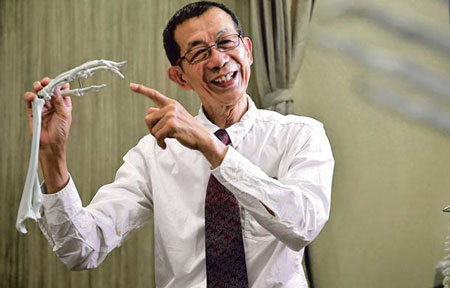Hand surgeon, lauded for 30 years of work in the field, helped set up medical speciality here
The Straits Times (21 May 2018) - Popping a champagne bottle on his wedding night would have been an impossible task for a young engineer whose hand was completely crushed during a work accident.
 Associate Professor Teoh Lam Chuan’s work focuses on restoring the function and appearance of the injured hand.
Associate Professor Teoh Lam Chuan’s work focuses on restoring the function and appearance of the injured hand.
ST PHOTO: KUA CHEE SIONG
But the groom managed to accomplish the task, thanks to surgeon Teoh Lam Chuan, who repaired the young man’s left hand after a machine fell on it almost 30 years ago.
Associate Professor Teoh has, in his own words, seen it all in this industry – he was the first-hand surgeon in Singapore and in 1988 headed the first department of hand surgery, which was set up at the Singapore General Hospital.
He also played a key role in established hand surgery as a medical speciality in Singapore in 1996.
On May 11, Prof Teoh won the Lee Foundation’s National Healthcare Group Lifetime Achievement Award in recognition of his 30 years of work in this field.
The hand is such an intricate structure that losing a finger would make simple tasks difficult, such as holding a pen.
“It is a very compact anatomy – the finger is 1cm in diameter but packed with so many fine structures,” said Prof Teoh, 69.
For him, what started out as exposure from a government scholarship became a lifetime’s worth of hard work and passion.
Under the Ministry of Health’s Health Manpower Development Plan, Prof Teoh clinched the opportunity in 1986 to travel to the Kleinert Hand Institute in the United States for a medical attachment.
There, he met doctors from all over the world, but none was Singaporean or from South-east Asia.
He returned to the institute the following year for further training.
After he came back to Singapore, he began practising as a hand surgeon at Tan Tock Seng Hospital in 1987, researching and refining techniques.
During his career, he also mentored over 10 batches of hand surgeons in Singapore and taught globally.
“You teach somebody how to fish, and they fish forever! What else can you give to the world, except training somebody else (so he or she can carry the knowledge forward)?” said Prof Teoh.
In the 1980s, amputation was the solution to most severe hand injuries – the one-hour procedure is much shorter and less complicated than the alternative 12-hour reconstructive surgery.
“Back then, Singapore was in its first phase of industrial development, and those industries (that had) production lines were very prone to hand injuries,” said Prof Teoh of the increased demand for the speciality at the time.
Reconstructive hand surgery focuses on restoring the function and appearance of the injured hand. For instance, a toe – usually the big or second toe, due to size – could be used to replace a missing thumb.
Today, hand surgery has been expanded to a range of conditions, from traumatic injuries of the hand to hand deformities and arthritis.
Despite his role as a mentor, one of his most memorable lessons came from interacting with a younger doctor 15 years ago.
At that time, a 15-year-old girl had undergone an operation to remove a tumour in her arm and replace a bone – but she began bleeding excessively during and after the operation.
“Bowls of blood were coming out from her every few hours,” he said. “The scariest part was that I didn’t know what was causing the bleeding. And I thought if it doesn’t stop, this patient might die on me.”
In his uncertainty, he consulted a younger doctor, who suggested that he re-operate on her. Despite his initial scepticism, he performed a successful second operation two days later and the patient survived.
Prof Teoh’s medical accomplishments were built on a heavy workload that came at a price: quality time with his family.
“Travelling around the world to teach is not just buying a ticket and going... it is a commitment that is quite time-consuming,” he said.
He confessed that 15 years into his career, he was ready to give it all up – if his wife had requested so. Despite the long hours apart, the 62-year-old housewife continues to support his work wholeheartedly. In fact, his work might have inspired two of their three children – their elder son, 39, and daughter, 30, are doctors in palliative care and family medicine, respectively.
The couple has another son, 35, who is an architect.
As for the legacy he wishes to leave behind, Prof Teoh said: “The speciality has been established – that itself is the legacy. (We came) from nothing in the beginning to a full recognisable speciality, and work is being continued now.”